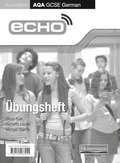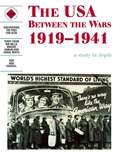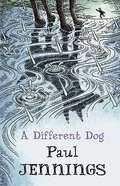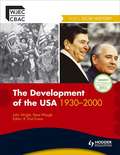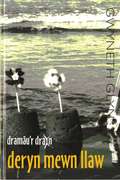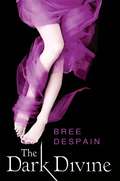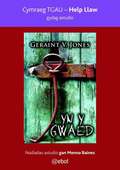- Table View
- List View
Echo Ubungsheft: Foundation AQA GCSE German (PDF)
by Oliver Gray Michael Wardle Harriette LanzerThis workbook features reinforcement activities to support exercises in the student book and extension tasks to take students onto the next level.
Echo: Higher AQA GCSE German (PDF)
by Oliver Gray Michael Wardle Harriette LanzerThis workbook features reinforcement activities to support exercises in the student book and extension tasks to take students onto the next level.
Echo: AQA GCSE German Higher (PDF)
by Michael Wardle Harriette LanzerEcho: AQA GCSE Higher Student Book has been written to prepare more able students for the latest AQA GCSE specification. With a strong focus on controlled assessment and exam preparation throughout the course, students can confidently aim for grades A*-C. Graded examples and examiner tips in Grade Studio show students how to aim for the best possible results through perfecting key language skills.
Dynamic Learning: Business Communication (PDF)
by Nina Rees Ian MarcouseKey features of the text include: - Numerous activities and exercises for classroom and homework use - Lots of real life case studies and examples to motivate and engage students - Tips and questions to prepare students for the exam.
Dramascripts: The Diary Of Anne Frank (PDF)
by Frances Goodrich Albert HackettAnne Frank and her family were Jews. Having fled from Germany to Holland in 1933 to escape the Nazis, they were forced into hiding in 1940 when Holland was invaded. This play draws heavily from the Diary that Anne left behind which she documented her and her family's life in their hiding place the attic above a factory.
Dramascripts: The Diary Of Anne Frank
by Frances Goodrich Albert HackettAnne Frank and her family were Jews. Having fled from Germany to Holland in 1933 to escape the Nazis, they were forced into hiding in 1940 when Holland itself was invaded. The play draws upon Anne's diary, which she documented her and her family's like in hiding in the attic above a factory.
Divergent (Divergent, Book 1) (PDF)
by Veronica RothShe turns to the future in a world that's falling apart. For sixteen-year-old Tris, the world changes in a heartbeat when she is forced to make a terrible choice. Turning her back on her family, Tris ventures out, alone, determined to find out where she truly belongs. Shocked by the brutality of her new life, Tris can trust no one. And yet she is drawn to a boy who seems to both threaten and protect her. The hardest choices may yet lie ahead ...
Distillation Apparatus (UEB Uncontracted)
by Rnib BookshareThis page shows six items of laboratory equipment used for separating liquids with different boiling points. They are seen from the side in cross section. Each image is labelled. There is a locator dot and title shown, which will be at the top left of the page when it is the correct way up.Condensers - On the left of the page, from left to right, are an Allihn condenser, a coil condenser and a Graham condenser. Each of them has a small tube inside a larger tube. In the Allihn and Graham condensers, the larger, outside tube carries a coolant, usually water or antifreeze. The coolant flows from the bottom left to the top left of the image. Arrows show the direction of flow. Hot vapour is passed through the smaller, inner tube. It cools and condenses to a liquid that is collected at the bottom. The inner tube of the Allihn condenser has a series of bulbs along its length, to increase its surface area and speed up the exchange of heat. The inner tube of the Graham condenser is coiled, also to increase its surface area. The coil condenser is a variant of the Graham condenser except the small coiled, inner tube carries the coolant and the hot vapour condenses in the larger, outside tube.Alembic Retort: This image in the top left of the page shows an alembic retort. It was used as part of an alembic still by the Ancient Greeks. The retort is being heated by a Bunsen burner down the page.Cold finger:This image is to the left of the Bunsen burner. Coolant (often water) flows into the cold finger in the top right of the image and out of the top left. The direction of flow is shown by arrows. The cold finger provides a cold surface and can be use as a simple condenser or in a sublimation apparatus.
Distillation Apparatus (UEB Contracted)
by Rnib BookshareThis page shows six items of laboratory equipment used for separating liquids with different boiling points. They are seen from the side in cross section. Each image is labelled. There is a locator dot and title shown, which will be at the top left of the page when it is the correct way up.Condensers - On the left of the page, from left to right, are an Allihn condenser, a coil condenser and a Graham condenser. Each of them has a small tube inside a larger tube. In the Allihn and Graham condensers, the larger, outside tube carries a coolant, usually water or antifreeze. The coolant flows from the bottom left to the top left of the image. Arrows show the direction of flow. Hot vapour is passed through the smaller, inner tube. It cools and condenses to a liquid that is collected at the bottom. The inner tube of the Allihn condenser has a series of bulbs along its length, to increase its surface area and speed up the exchange of heat. The inner tube of the Graham condenser is coiled, also to increase its surface area. The coil condenser is a variant of the Graham condenser except the small coiled, inner tube carries the coolant and the hot vapour condenses in the larger, outside tube.Alembic Retort: This image in the top left of the page shows an alembic retort. It was used as part of an alembic still by the Ancient Greeks. The retort is being heated by a Bunsen burner down the page.Cold finger:This image is to the left of the Bunsen burner. Coolant (often water) flows into the cold finger in the top right of the image and out of the top left. The direction of flow is shown by arrows. The cold finger provides a cold surface and can be use as a simple condenser or in a sublimation apparatus.
Distance-time graph (Large Print)
by Rnib BookshareThis page shows a graph of distance plotted against time. There is a locator dot shown, which will be at the top left of the page when the image is the right way up. A background grid of light vertical and horizontal lines covers most of the page. To the far left is a vertical scale, the y-axis, which is marked in divisions of 50 metres going up the page from 0 to 400. At the bottom of the page is a horizontal scale, the x-axis, which is divided into intervals of ten seconds going from 0 on the left to 70 on the right of the page. There is a heavy line starting at the bottom left of the grid where zero is marked that slopes up to the right. It is horizontal between 30 and 50 seconds and then slopes up again. To the far right of the page is a vertical line showing distance travelled and below this, to the left, is a line showing time taken for this section of the graph line. Up and to the left of centre of the page there is the equation: speed = y/x. In the equation 'x' refers to the time (on the x-axis, going left to right) taken to travel a distance and 'y' (on the y-axis, going bottom to top) to the distance travelled in that time.
Distance-time graph
This page shows a graph of distance plotted against time. There is a locator dot shown, which will be at the top left of the page when the image is the right way up. A background grid of light vertical and horizontal lines covers most of the page. To the far left is a vertical scale, the y-axis, which is marked in divisions of 50 metres going up the page from 0 to 400. At the bottom of the page is a horizontal scale, the x-axis, which is divided into intervals of ten seconds going from 0 on the left to 70 on the right of the page. There is a heavy line starting at the bottom left of the grid where zero is marked that slopes up to the right. It is horizontal between 30 and 50 seconds and then slopes up again. To the far right of the page is a vertical line showing distance travelled and below this, to the left, is a line showing time taken for this section of the graph line. Up and to the left of centre of the page there is the equation: speed = y/x. In the equation 'x' refers to the time (on the x-axis, going left to right) taken to travel a distance and 'y' (on the y-axis, going bottom to top) to the distance travelled in that time.
Distance-time graph
This page shows a graph of distance plotted against time. There is a locator dot shown, which will be at the top left of the page when the image is the right way up. A background grid of light vertical and horizontal lines covers most of the page. To the far left is a vertical scale, the y-axis, which is marked in divisions of 50 metres going up the page from 0 to 400. At the bottom of the page is a horizontal scale, the x-axis, which is divided into intervals of ten seconds going from 0 on the left to 70 on the right of the page. There is a heavy line starting at the bottom left of the grid where zero is marked that slopes up to the right. It is horizontal between 30 and 50 seconds and then slopes up again. To the far right of the page is a vertical line showing distance travelled and below this, to the left, is a line showing time taken for this section of the graph line. Up and to the left of centre of the page there is the equation: speed = y/x. In the equation 'x' refers to the time (on the x-axis, going left to right) taken to travel a distance and 'y' (on the y-axis, going bottom to top) to the distance travelled in that time.
Discovering the Past: USA Between the Wars, 1919-41 (PDF)
by Rik Mills Schools History Project Carol White Maggie SamuelsonThis is an SHP Official Text which means it has been created by the Schools History Project for use with the GCSE specifications. This is part of SHP's comprehensive and authoritative range of books for GCSE History. Seehttp://www.schoolshistoryproject.org.uk/Publishing/index.htm to find out more about the Schools History Project and their award winning publications.The USA between the Wars is comprehensive and authoritative depth study for use with all GCSE specifications. It thoroughly covers the content requirements of OCR, Edexcel and AQA's specifications using an enquiry based approach. It is also a popular international text being widely used in Australia.It is written by experts who understand both how to design good teaching material but also understand the exact assessment requirements of each specification.The book combines:- Clear explanation of specification content- Classroom-trialled activities that really motivate students- Extensive and intriguing source material and case studiesThis book will enliven any history course and will help students achieve the top grades at GCSE.It is supported by a comprehensive Teacher's Resource Book,
Discovering the Past: USA Between the Wars, 1919-41 (PDF)
by Rik Mills Schools History Project Carol White Maggie SamuelsonThis is an SHP Official Text which means it has been created by the Schools History Project for use with the GCSE specifications. This is part of SHP's comprehensive and authoritative range of books for GCSE History. Seehttp://www.schoolshistoryproject.org.uk/Publishing/index.htm to find out more about the Schools History Project and their award winning publications.The USA between the Wars is comprehensive and authoritative depth study for use with all GCSE specifications. It thoroughly covers the content requirements of OCR, Edexcel and AQA's specifications using an enquiry based approach. It is also a popular international text being widely used in Australia.It is written by experts who understand both how to design good teaching material but also understand the exact assessment requirements of each specification.The book combines:- Clear explanation of specification content- Classroom-trialled activities that really motivate students- Extensive and intriguing source material and case studiesThis book will enliven any history course and will help students achieve the top grades at GCSE.It is supported by a comprehensive Teacher's Resource Book,
A Different Dog (PDF)
by Paul Jennings Geoff KellyThe child narrator of A Different Dog can't speak - we assume it is from a disability or a reaction to a trauma in his past. He is teased by the other kids and is a loner. On a cold winter's day, when everyone is participating in a fun run on the mountain, our narrator finds himself alone at the scene of a car accident where the driver has died. But there is a little dog in the car... What follows is a moving story of survival and redemption (and somehow humour in the midst of all that), all told in a 96-page novella.
The Development of the USA, 1929-2000 (PDF)
by Steve Waugh Paul Evans John WrightWritten by experts and endorsed by WJEC, this series gives students in-depth topic-focused content and structured support with exam skills for WJEC GCSE History. This series for WJEC GCSE History has been written to encourage students to achieve their best. It does this by combining detailed narrative and a rich variety of sources with a highly structured approach to gradually developing students' skills in answering exam-style questions as they work through the course. Allows students to gain a good knowledge and understanding of the content by outlining and examining the key issues of the GCSE history topic in turn. Develops students enthusiasm for learning the topic through a variety of activities designed to engage and motivate them. Helps student feel secure in how they will be assessed by providing dedicated support in how to answer different exam-style questions, including exam-model answers, exam tips and commentary. The Development of the USA 1929-2000 This title focuses on the key trends and turning points that have affected the development of the USA between 1929-2000. It considers the developments, events and personalities which have shaped the recent history of the USA.
Development of a tropical storm - map (UEB Uncontracted)
This diagram shows the development of a tropical storm, in map view (seen from above). There is a locator dot shown, which will be at the top left of the page when the image is the right way up. The image is surrounded by an image border. Most of the border is filled with a texture representing the sea. To the left of the page are descriptive labels and to the right a textured object shaped roughly like a ring doughnut. At the bottom left of the page, just above a label, are two arrows pointing to the left, indicating the direction of travel of the storm system. The right hand portion of the page shows the ring-shaped storm system with the clear 'eye' at its centre. It is surrounded by arrows showing the anti-clockwise (in the northern hemisphere) rotational direction of the system.
Development of a tropical storm - map (UEB Contracted)
This diagram shows the development of a tropical storm, in map view (seen from above). There is a locator dot shown, which will be at the top left of the page when the image is the right way up. The image is surrounded by an image border. Most of the border is filled with a texture representing the sea. To the left of the page are descriptive labels and to the right a textured object shaped roughly like a ring doughnut. At the bottom left of the page, just above a label, are two arrows pointing to the left, indicating the direction of travel of the storm system. The right hand portion of the page shows the ring-shaped storm system with the clear 'eye' at its centre. It is surrounded by arrows showing the anti-clockwise (in the northern hemisphere) rotational direction of the system.
Development of a tropical storm - map (Large Print)
This diagram shows the development of a tropical storm, in map view (seen from above). There is a locator dot shown, which will be at the top left of the page when the image is the right way up. The image is surrounded by an image border. Most of the border is filled with a texture representing the sea. To the left of the page are descriptive labels and to the right a textured object shaped roughly like a ring doughnut. At the bottom left of the page, just above a label, are two arrows pointing to the left, indicating the direction of travel of the storm system. The right hand portion of the page shows the ring-shaped storm system with the clear 'eye' at its centre. It is surrounded by arrows showing the anti-clockwise (in the northern hemisphere) rotational direction of the system.
Development of a tropical storm - cross section (UEB Uncontracted)
This page shows a tropical storm in cross section (cut through vertically and seen from the side). There is a locator dot shown, which will be at the top left of the page when the image is the right way up. The diagram has a dashed line image border. In the middle of the page there are arrows pointing down, and to either side of these the cross section through the clouds can be found. Going across the bottom of the page is a textured area representing the sea. The straight arrows in the middle of the page represent the flow of air down into the clear 'eye' of the storm system. To either side are textured areas of cloud. Within these textured areas, wiggly arrows show water vapour rising through the cloud from the sea. Rain is shown falling from the cloud to the sea at the bottom of the page. Three horizontal arrows, pointing right, can be found on the left of the page just above the sea. Three similar arrows, pointing left, can be found just above the sea on the right of the page. These all show airflow into the storm system.
Development of a tropical storm - cross section (UEB Contracted)
This page shows a tropical storm in cross section (cut through vertically and seen from the side). There is a locator dot shown, which will be at the top left of the page when the image is the right way up. The diagram has a dashed line image border. In the middle of the page there are arrows pointing down, and to either side of these the cross section through the clouds can be found. Going across the bottom of the page is a textured area representing the sea. The straight arrows in the middle of the page represent the flow of air down into the clear 'eye' of the storm system. To either side are textured areas of cloud. Within these textured areas, wiggly arrows show water vapour rising through the cloud from the sea. Rain is shown falling from the cloud to the sea at the bottom of the page. Three horizontal arrows, pointing right, can be found on the left of the page just above the sea. Three similar arrows, pointing left, can be found just above the sea on the right of the page. These all show airflow into the storm system.
Development of a tropical storm - cross section (Large Print)
This page shows a tropical storm in cross section (cut through vertically and seen from the side). There is a locator dot shown, which will be at the top left of the page when the image is the right way up. The diagram has a dashed line image border. In the middle of the page there are arrows pointing down, and to either side of these the cross section through the clouds can be found. Going across the bottom of the page is a textured area representing the sea. The straight arrows in the middle of the page represent the flow of air down into the clear 'eye' of the storm system. To either side are textured areas of cloud. Within these textured areas, wiggly arrows show water vapour rising through the cloud from the sea. Rain is shown falling from the cloud to the sea at the bottom of the page. Three horizontal arrows, pointing right, can be found on the left of the page just above the sea. Three similar arrows, pointing left, can be found just above the sea on the right of the page. These all show airflow into the storm system.
Deryn Mewn Llaw (Dramâu'r Drain)
by Gwyneth GlynDrama fywiog yng nghyfres Dramâu'r Drain; delfrydol i ysgolion, ac ar gyfer myfyrwyr yn eu harddegau. Pedwar cymeriad 15 mlwydd oed sy'n y ddrama hon - Becky, Gwawr, Elis a Deiniol, a chawn hanes eu hynt a'u helynt yn ystod gwyliau'r haf. [A lively drama in the Dramâu'r Drain series; ideal for schools, and for teenagers. Four fifteen-year-olds are the characters of this drama - Becky, Gwawr, Elis and Deiniol, and it portrays their time together during a summer school holiday.] *Datganiad hawlfraint Gwneir y copi hwn dan dermau Rheoliadau (Anabledd) Hawlfraint a Hawliau mewn Perfformiadau 2014 i'w ddefnyddio gan berson sy'n anabl o ran print yn unig. Oni chaniateir gan gyfraith, ni ellir ei gopïo ymhellach, na'i roi i unrhyw berson arall, heb ganiatâd.
The Dark Devine, Book 1: The Dark Divine (PDF)
by Bree DespainA prodigal son. A dangerous love. Haunted yearning ... Now that Daniel's returned, Grace must choose between her growing attraction to him and her loyalty to her brother. As Grace gets closer to Daniel, she learns the truth about that mysterious night and how to save the ones she loves, but it might cost her the one thing she cherishes most: her soul.
Cymraeg TGAU – Help Llaw gydag astudio Yn y Gwaed
by Menna Baines Bethan Clement Eirian Jones Ceri JonesNodiadau astudio ar gyfer myfyrwyr sy'n astudio Testunau gosod TGAU llenyddiaeth Gymraeg. Mae'r nodiadau adolygu yn ymwneud â'r plot, y cymeriadau, y math o themâu a geir yn y nofel, a'r technegau arddull y mae'r nofelydd yn eu defnyddio. Mae hefyd cyfres o ymarferion a thasgau pwrpasol wedi'u cynnwys. *Datganiad hawlfraint Gwneir y copi hwn dan dermau Rheoliadau (Anabledd) Hawlfraint a Hawliau mewn Perfformiadau 2014 i'w ddefnyddio gan berson sy'n anabl o ran print yn unig. Oni chaniateir gan gyfraith, ni ellir ei gopïo ymhellach, na'i roi i unrhyw berson arall, heb ganiatâd.
